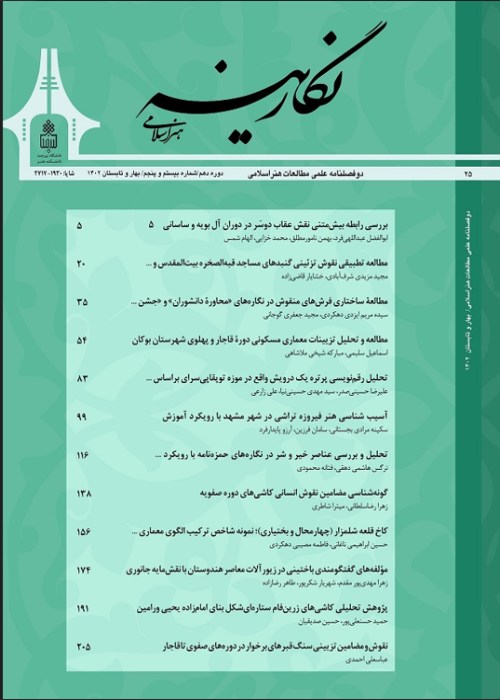Comparative Study of Demons Painting in the Painting Schools of Ilkhani and Timurid Eras
Author(s):
Article Type:
Research/Original Article (بدون رتبه معتبر)
Abstract:
The confrontation between good and evil forces, the division of the world into two realms of light and darkness, and the belief in the permanent quarrel between Ahoorian and Devilish phenomena, is a common belief among all folks and nations, a struggle that continues till the world is set up, and the ultimate victory belongs to the light front. Demons, who are the inhabitants of the darkness, are abnormal, black creatures with long, hog-like teeth, thick and black lips, and occasionally blue eyes. The body of these cannibals is covered with thick hair and they have several heads, horns, tails and large ears with a pair of wings. Demons are one of the most devilish creations in Iranian mythology, whose main goal is to eliminate Ahoorian creatures. Ferdowsi has shown this idea in his Shahnameh; it is even seen in the epic poems afterward. Meanwhile, Demons, which represents the devil and enemy, is shown as naked animal figures with horns and tail, possessing primitive weapons. The painters have somehow emphasized the superiority of the creation of the goddess against devilish creation by displaying these features. The main goal of the research is to study the role of the Demons in Ilkhani and Timurid eras (Herat and Shiraz) and their differences in their images. The main questions of this research are: 1. what are the characteristics of Demons in the paintings of the Ilkhani and Timurid eras? 2. How can the difference between the face of the Demons in Ilkhani and Timurid periods be explained? The results of the study showed that in the painting of this era, Demons are depicted with the animal nature in the shape of human body. On the other hand, the difference in the shapes of Demons in these schools is first drawn from the metaphorical aspect of Shahnameh, and then the personal perception of the painter and his interpretation of the text, the artistic style of his era, the cultural conditions and the school in which he grew. This research has been accomplished by a descriptive-analytical and comparative method, based on library studies.
Language:
Persian
Published:
Journal of Negarineh Islamic Art, Volume:3 Issue: 11, 2016
Pages:
62 to 75
magiran.com/p1863085
دانلود و مطالعه متن این مقاله با یکی از روشهای زیر امکان پذیر است:
اشتراک شخصی
با عضویت و پرداخت آنلاین حق اشتراک یکساله به مبلغ 1,390,000ريال میتوانید 70 عنوان مطلب دانلود کنید!
اشتراک سازمانی
به کتابخانه دانشگاه یا محل کار خود پیشنهاد کنید تا اشتراک سازمانی این پایگاه را برای دسترسی نامحدود همه کاربران به متن مطالب تهیه نمایند!
توجه!
- حق عضویت دریافتی صرف حمایت از نشریات عضو و نگهداری، تکمیل و توسعه مگیران میشود.
- پرداخت حق اشتراک و دانلود مقالات اجازه بازنشر آن در سایر رسانههای چاپی و دیجیتال را به کاربر نمیدهد.
In order to view content subscription is required
Personal subscription
Subscribe magiran.com for 70 € euros via PayPal and download 70 articles during a year.
Organization subscription
Please contact us to subscribe your university or library for unlimited access!


